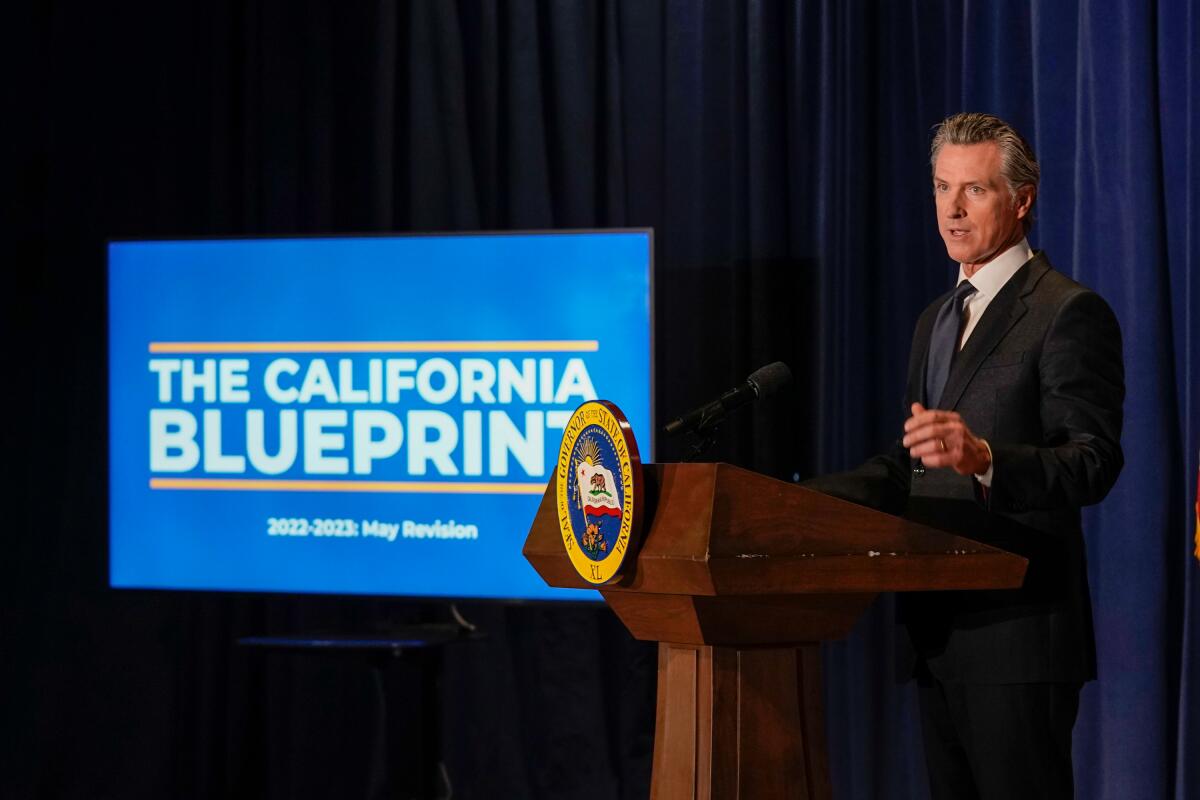California Politics: What wasn’t in the state budget

SACRAMENTO — So you’ve heard. California has more money than ever.
The budget plan signed by Gov. Gavin Newsom at the end of June hit a historic $307.9 billion and anticipates a record-high surplus.
That includes gas refunds for taxpayers as prices at the pump soar, an expansive reproductive health plan as abortion access is threatened nationwide and new benefits for California’s most vulnerable, including extended tax credits and utility payment support.
But today we’re talking about what’s not in the budget.
I’m Mackenzie Mays, and I cover policy and state government with a focus on equity, poverty and California’s burgeoning wealth gap.
While many are celebrating the state’s explosive revenue — celebrations tempered by an unknown economic future — some lobbyists, advocates and lawmakers in Sacramento are mourning the darlings that were killed.
Kristina Bas Hamilton, who heads a lobbying firm focused on advocacy and labor organizations, tried to get funding in the budget for a new guaranteed income program for high school seniors who are unhoused — legislation spearheaded by state Sen. Dave Cortese (D-San Jose.)
Proponents of the bill asked for $50 million, enough to get $650 monthly payments into the pockets of eligible students for five months as part of the proposed pilot project. But the idea did not survive budget negotiations.
With more money can come more demand and tenser negotiations between the governor and lawmakers about California’s priorities. But that’s better than the alternative, Bas Hamilton said.
“I had the terrible experience of having done a lot of work in the budget during the recession, and I’ll tell you, wrestling a dollar from the Jerry Brown administration during the recession years was like squeezing blood from a stone,” she said. “Now that we have been in flush economic times, it makes it easier, but it’s still generally very difficult.”
Budget season is over, though there’s still a chance for a Hail Mary for the lucky few. The Legislature could make room in the budget by approving new bills when it reconvenes in August — and hope for the governor’s signature.
Lobbyists like Bas Hamilton are already preparing for the next budget, when the process will start all over again in January.
Here are some of the initiatives that didn’t make the cut this fiscal year:
Health equity and racial justice fund
For the second year in a row, an effort to create a state fund focused on health equity and racial justice has failed.
While the Senate and Assembly proposed $75 million in ongoing annual funding for a new Health Equity and Racial Justice Fund, there is no such funding in the final version of the budget signed by the governor.
The funding would have been used to assist local organizations and clinics in tackling a slew of health disparities and increase access to care while also focusing on contributing factors such as employment, transportation and criminal justice.
As my colleague Marissa Evans reported, proponents of the program criticized Newsom for not championing the fund. Without it,
disproportionate health problems will continue to exist for communities of color and force them to compete for access to much needed aid, advocates said.
H.D. Palmer, spokesperson for Newsom’s Department of Finance, pointed to $300 million in the budget to support the Department of Public Health and local health jurisdictions as a way the state is tackling the problem. That budget plan “provides funding that will continue progress” on the equity issue, he said, including a focus on social determinants of health like race and poverty.
Help for counties to administer benefits
While the budget boosts the funding and reach of some government assistance programs, counties that administer those benefits have been ringing alarms about an inability to keep up with demand.
County offices in charge of distributing monthly food benefits to low-income Californians say they are understaffed and overwhelmed, which has led to delays in services and longer wait times for those in need.
This year, a program leader in Marin County told me that she maintains a 16% to 20% staff vacancy rate there while applications for CalFresh services increased by 70% between 2017 and 2021.
The County Welfare Directors Assn. had requested $60 million for CalFresh administration costs, but the budget included $35 million.
CWDA Executive Director Cathy Senderling-McDonald said that is not enough for counties to provide timely services to millions of Californians every day.
“Counties continue to face challenges in recruiting and retaining staff to provide these supports and the budget, unfortunately, does not fully fund the administrative work required of counties across all of our programs and services,” she said.
The Child Support Directors Assn. of California also voiced disappointment regarding funding in the budget for local agencies in charge of delivering that money to families.
“Unfortunately, this budget does not do enough to support California’s children, particularly children of color, and families served by” local child support agencies, the group said in a statement.
Paid family leave and disability benefits
California’s paid family leave and state disability rates fall short compared with other states, and many workers who need time off the most don’t use it because payments are not enough, according to a report by the California Budget & Policy Center.
Most California workers are eligible for up to eight weeks of paid time off to tend to a sick family member or bond with a new child.
For most workers with “very low” wages, the payments equal to 70% of their earnings, and for other workers, to 60%, according to the report.
Without any state intervention soon, those rates are set to decline, and will revert to a rate of 55% of workers’ earnings. (In 2018, state officials temporarily increased payments for the programs, and now time is up.)
While both the governor and the Legislature had proposed solutions to increase the benefits or extend the current rates, there was no mention of the issue in the budget finalized last month. Negotiations could continue, but advocates are on edge.
“This has become a benefit in name only — workers have to choose between paying the bills and caring for themselves or their family,” said Sarah Jimenez, spokesperson for the California Budget & Policy Center.
Food benefits for all undocumented immigrants
With this budget, California became the first state to offer food benefits to immigrants residing in the country illegally.
The budget includes $35.2 million to expand the state’s food assistance program to residents older than 55 “regardless of immigration status,” and funding for the new program is set to increase to $113.4 million annually in 2025-26.
The first-of-its-kind policy fills in safety net gaps, as immigrants without legal status are not eligible for federal benefits such as food stamps.
The Newsom administration says the policy targets a vulnerable population that is often overlooked. But the budget deal dismisses pleas by anti-poverty advocates to cover all ages.
The new policy is estimated to benefit an additional 75,000 Californians each year, according to a report by the Legislative Analyst’s Office. The need for food benefits among immigrants who do not have legal status is estimated to be much greater.
According to a report released in April by Nourish California, a human rights and food access organization, nearly half of Californians without legal immigration status struggle with food insecurity, and the majority of those are adults ages 27 to 49.
“While this is an important investment, many immigrants under the age of 55 will remain locked out of CalFresh, our most powerful anti-hunger program,” the Food4All Coalition said in a statement. “We will continue to work with the immigrant community and state leaders until all Californians have access to food assistance. No exceptions. No exclusions.”
California politics lightning round
— Newsom took his frustrations with red-state Republicans — and his own party — on the road, as he accepted an education award in Washington, D.C.
— Another gun control measure became state law this week, establishing a “firearm industry standard of conduct,” part of a spate of bills aiming to curb a surge in gun violence.
— The governor defended a trip to visit his in-laws in Montana.
— A landmark tax on millionaires passed by California voters decades ago has fallen short on its promises to aid mental health.
Stay in touch
Did someone forward you this? Sign up here to get California Politics in your inbox.
Until next time, send your comments, suggestions and news tips to [email protected].
Sign up for Essential California
The most important California stories and recommendations in your inbox every morning.
You may occasionally receive promotional content from the Los Angeles Times.




